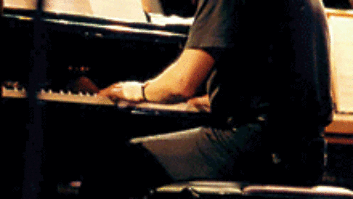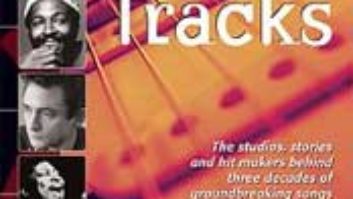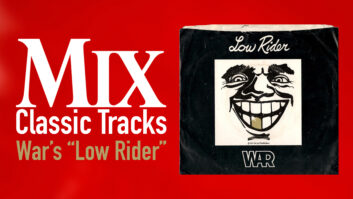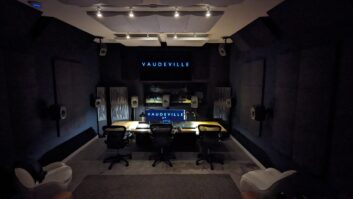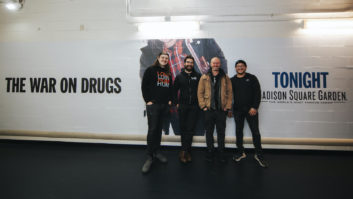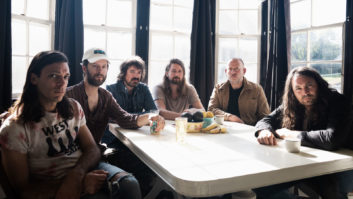Something special occurred in Hollywood during the last half of 1998, something only a handful of people will truly appreciate because most of it was orchestrated behind closed doors at Warner Bros. and Fox. Terrence Malick, the reclusive director of Badlands and Days of Heaven, had returned to filmmaking after a 20-year absence. It was as if the Prodigal Son had come home, and the town was buzzing about his new project: The Thin Red Line. The World War II drama is based on the raw and gripping James Jones novel about C-for-Charlie Company and the siege of Guadalcanal.
Once word began trickling out, it became clear that Malick had made a different kind of war movie, one that is highly impressionistic and personal. Composer Hans Zimmer explained, “I said to Terry at the beginning that the one thing I’m not interested in doing is yet another war movie where you go, ‘War is horrible, war is terrible.’ That’s been said millions of times, and I have a feeling Steven [Spielberg] just said it better than anybody else [in Saving Private Ryan], so let’s not go there. Terry wanted poetry, not prose.”
The challenge from the start, it seems, was to make a “delicate” war movie: what Malick would often describe as “oceanic,” “flowing,” constantly moving, in picture and in sound. It was especially true for the sound crew because reels 5 to 13 (it’s a 17-reel film, nearly three hours) are one long battle, complete with light weapon fire, ricos, mortars and howitzers. The key, according to supervising sound editor Paul Huntsman, “was to look at the film itself. The way it was shot and edited asked nothing more than to simply be expressed in some beautiful, soft way that forced you to think in simplistic scenarios. And that funnels right into Terry’s sense of a minimalistic approach to sound: Only the things that you really need to hear, and just make damn sure they’re the appropriate sound.”
ON LOCATION: PRODUCTION MEETS POST”Minimalist” sound does not mean few sounds, or the absence of sound. It’s more about the appropriate effect; or the single, long, dynamic note; or the right breathing on the battlefield. In fact, the crew at Warner Bros. Post-Production Services, the core of which has worked on Huntsman’s five most recent pictures, had mountains of material. Ships, landing craft, additional weapons and winds were recorded in and around L.A. by John Fasal and Jayme S. Parker. But the bulk of the material, about 250 hours worth of elements on DAT, was sent from location in Australia in what Huntsman calls an “absolutely novel” collaboration between production and post.
Production sound mixer Paul “Salty” Brincat, an animated 25-year veteran from New South Wales, and second unit mixer Greg Bergmann proved to be the unsung heroes of the film. At every spare moment, they recorded backgrounds, vehicles, birds, soldiers walking through grass, you name it. They even went so far as to spend two additional weeks on the Solomon Islands recording birds (Malick, an ornithologist, was particular about getting the birds right), ambiences and specific effects. Indigenous music was recorded in coordination with Claude Letessier, a colleague of Zimmer’s at Media Ventures. When production wrapped, Salty spent additional days recording light weapons and howitzers. All this was in addition to turning over “excellent, excellent dialog work, the best I’ve heard in a long time,” says ADR supervisor Hugh Waddell.
And it couldn’t have been easy. More than a million feet of film were shot, according to reports, and principal photography took place over about six months in Australia, including 12 weeks on a hill for the battle sequences: actors on the run, diving down, leaping up, screaming, whispering, in rain, in wind. “I went in thinking this would be a pretty standard feature,” Salty recalls. “But as we started to get into the shoot a couple of weeks, I thought, ‘Boy, I gotta change my ways here.’ I started thinking that I had to get back to where I was when I was put into the field to do docos [documentaries] and put in situations to capture sound as simply as I could and be sure to get what I could get. Obviously, I needed to get feature sound for them but approach it in a documentary way. [Terry] kept the pace moving. He kept it zooming and he kept rolling. My best choice, I gotta say, was when I decided to have two boom operators.”
Rod Conder and Gary Dixon ran the hill with the actors day in and day out, carrying Sennheiser 816s and 416s on the end of 18-foot fishpoles. It was tiring work, and Salty sang their praises. “These guys really did work it,” he says. “They were using Steadicams and running through battles. That’s why we had to use booms. You can’t put body mics with full webbing gear and thick terrain. You might get slightly tighter, but at the same time I would have lost more by getting rustle, getting thumping, possibly getting a mic ripped if one of theactors dives down because of an explosion effect, then gets up and charges, then dives down to do their dialog. It made sense for us to radio-mike the booms themselves and just run free. And I mean run free-they could run up to 200, 400 yards away in a sequence. And they’d be running up hills. It was pretty demanding on the guys, and they did fantastic.
“It’s funny,” he continues. “I hadn’t used the 816 for quite a while, but I tell you what, she’s back in the truck and she’s staying with me because she worked it out. I guess it’s getting back to docos, ’cause in the old days you used an 816 when you didn’t know your distances. And you were always ready.”
Because of the terrain, Salty didn’t have the luxury of a cart, so he scaled back his rig considerably. About three years ago, because he works extensively in the tropics and around sand, he converted an esky (what we in the States would call a cooler) into a portable sound-protection unit. The preamps are housed in a custom-fitted lid, a fan was built into the side, and inside he keeps an Audio Development 206 4-channel mixer, a Fostex PD-2 DAT machine (primary recorder), a backup Sony TCD-8 DAT Walkman, a Comtek to feed the timecode slates, and a feed for the director and whoever else wanted to hear program. That esky, plus a mic bag, plenty of HHB DAT stock and batteries, and a “brelly” to shield the sun and rain, was all he carried.
When Salty and Bergmann went out to record effects, atmospheres and weapons, they usually took more equipment, including a 6-channel Pico mixer, AKG C-552 stereo mics (atmospheres, in an X-Y pattern), AKG 568 and 300SBs Blue Line condensers (interior tents), and Nagra 4.2 and stereo recorders (gunshots and explosions). Bergmann even borrowed a Sony PCM-800 8-track from the picture-editing department for recording vehicles and aircraft. Two weeks were spent in the Solomon Islands recording the landing scene on Guadalcanal. They also went on a four-hour trek into the jungle to record atmospheres and choirs, the most stunning of which was a 60-voice Melanesian ensemble recorded in a church that the art department built. Various themes, as well as original material, were brought back by Letessier and wound their way into portions of Zimmer’s hypnotic score.
The need to record authentic, period weapons-both small arms and heavy artillery-was obvious. Producer Grant Hill arranged for Salty to spend a day (which, because of wind, turned into two days) with the Australian army on a firing range outside of Sydney. After faxing mic plots back and forth to Huntsman, mics were set up all over the 400-yard-long field, especially near the impact points, where they fired into sand and grass walls.
A couple of weeks later, Salty took Conder with him to record the howitzers, the 105mm cannons, in Victoria. He was expecting one gun and got 12. The regiment set him up in a camouflaged truck in the middle of the range and fired over him. Then they offered him the unique opportunity of recording as the troops rolled the cannon up a hill and fired into a dirt mound a kilometer away. “You see the round leave the gun,” Salty explains. “You see it hit, you see the white flash, you see the dirt rise up, and about 15 seconds later-an unbelievable amount of delay-you hear this huge crack that comes back at you. Absolutely fantastic.
“We chased and got live rounds,” he continues. “The crack in the air was just fantastic. I’ve never been able to get that involved in post. I gotta say, that excited me to run around and be able to record all the gear. And the director gave me the time and direction to do it. It’s one thing for a director to say, ‘This is what I want.’ It’s another thing for a director to say, ‘Hey, there’s the time, go get it.'”
“I have never seen this kind of work done on a film,” Huntsman says of Salty and Bergmann. “And I’ve never seen such dedication and concern about it. Good record keeping, great recording work and an enthusiasm that absolutely shows in their work. A lot of what this movie is about in terms of how it sounds has to do with the care and deliberate nature of the way these guys went about their job.”
BACK IN HOLLYWOODHuntsman and his crew were finishing up Deep Impact in late spring, but every couple of weeks they received anywhere from six to 20 DATs from Australia. First to come were backgrounds, then vehicles and aircraft, then weapons. At the same time, Huntsman, an avid reader, was poring over World War II literature and diaries. One of the most valuable, Touched With Fire, was recommended by Malick and included first-hand reminiscences of the siege on Guadalcanal.
During the last week of June, in the midst of assembling libraries, the film was turned over and the sound team had a rare opportunity to view the rough 4.5-hour cut. Huntsman called the experience “mesmerizing, a treat beyond any, and a wonderful place to start out as a crew.” Right before they began editing, the crew lobbied to divide the work according to effect-one for guns, one for vehicles, one for BGs, etc. Huntsman, who typically turns over whole reels to editors, agreed.
“Two things swayed me,” he says. “I knew Jayme Parker would be the perfect individual to cut backgrounds on this movie. He is a quiet, hardworking, well-read, extremely focused guy. The other thing was that we had recorded this gigantic gun library-the entire, legitimate arsenal of what the American and Japanese armies carried into Guadalcanal-from three different shoots, and I needed somebody to construct that library of material. And Chris Aud became that guy.” John Bonds took on heavy weaponry, meaning anything that exploded, and Andy Sommers handled vehicles, aircraft and miscellaneous elements.
While Huntsman spent the last three-and-a-half months of the process on the dub stage, his co-sound supervisor Robb Wilson managed the crew back at Warner Bros. “with aplomb and a genuine sense of inspiration.” Dialog and effects were edited entirely on Fairlight MFX3 Plus systems; Foley and ADR were recorded directly to Fairlight drives. Foley was supervised by Jeff Rosen, walked by John Roesch and Hilda Hodges, and recorded by Mary Jo Lang. Dialog was cut by John Reynolds, Patrick Foley and Virginia Cook McGowan.
“My first thoughts were, ‘How do you make a battle movie soundtrack work that is long and has sustained portions of gunfire?'” says Huntsman. “How can you keep an audience sitting in their seats and still play guns, mortars and ricos and not drive them out of the theater? How do I control the dynamic so that it doesn’t become an offensive wall of material after a while? Easy-on-the-ear gunshots was the concept I came up with originally. I knew I wanted something that had power in the weaponry but not the kind of edge that would wear on your ear. There’s a couple of moments in the movie where you’re close to a soldier firing an M1 rifle and you can practically feel the kick of the gun, but it’s not hard to listen to. It doesn’t hurt your ears. It just feels solid.
“Then Terry’s first conversations with me were about dynamic range and perspective,” Huntsman continues. “We never really talked about the sound of the movie as much as the structure of the sound of the movie. There was always the necessity of having something in the foreground so that whatever played in the background had even more weight and perspective. It’s the equivalent, I guess, of the deep-focus shot. There are always these layers of imagery, and I think that’s what Terry wants to hear. He wants to hear the whole scene. He believes, and I agree with him, that having the appropriate material in the foreground acts as a lens that allows you to see more deeply into the background. Group ADR and the vocal nature of the battlefield would be a good example.”
ADR Supervisor Hugh Waddell also worked on Titanic, so he was not intimidated by the amount of material needed, most of which was alternative readings and offscreen changes. But he did find the edit a bit tricky in that Malick demanded such a natural feel to the dialog. “You can’t just present him with wall-to-wall loops and hope to get away with it,” Waddell says. “You have to literally use two or three words from production, then maybe three words from loops, then back to production. You really have to piece it together. It’s very difficult to tell what’s looped in this film because we have mixed it up so much.”
Most of the ADR was recorded at Warner Hollywood with mixer Tom O’Connell. A military adviser and Japanese interpreter were present at all times to ensure period authenticity. The bulk of the work involved generalized, wild recordings of group ADR by an all-male cast from L.A. Mad Dogs. Specifics were avoided until the “dying gasps” of the premix, according to Waddell, so that they didn’t overshoot.
“We were going for a documentary feel,” Waddell says, echoing the production process. “We came up with a way for the loop group actors to say lines in a way we called ‘nondescript dialog.’ They said lines, but they didn’t say the actual words. If you put it behind people speaking, you just think it’s people talking offscreen, but your ear isn’t drawn to it. It would just lie there as a bed, and you can play it relatively loudly and it just fits in with the scenes.
“So we put those nondescript lines in the background,” he continues, “but in the foreground, especially during heavy battle sequences, Terry had us record a lot of very close-up, very personal, intimate kinds of sobbing and moaning and sighing. When you’re looking at a field full of men dying, suddenly you’ll hear a moan or just a sigh-very up close and very personal, and it sort of pulls the whole scene toward you.”
Breathing, another element used to personalize scenes, was recorded for every character. And 80 to 100 hours of voice-over/narration were recorded; some of it was in place for the final but most of it was expected to be added during the last week of the mix.
Foreground/background was also dealt with in effects, perhaps most notably in scenes of soldiers crawling, diving or running through grasslands. Using the library of material from Australia, the crew might spread rather broad M-S recordings of 50 soldiers moving through grass, coupled with an X-Y version of the same track, somewhat offset, along with Foley and production. In the background, then, rests a deep, rich, hypnotic wind. The result, Huntsman says, is the “creme brulee of sound effects.”
“[Once we started listening] we could all see a way to make this movie delicate,” Huntsman says. “[In] one of my favorite shots in the movie, you see maybe 100 or more Americans hunched over and moving through very tall grass. You’re looking up this hillside, and the lieutenant in the foreground stops and does a hand signal, and all these men drop down behind him. These guys literally disappear in the environment where they’re probably going to die. And it’s so allegorical to the thoughts of these men and what might lie in store for them. At the same time it’s absolutely descriptive of the environment that these men find themselves in. If you don’t get it when you see that shot, it’s because you’re thinking about popcorn or something. It’s just a wonderful moment. There’s not a lot of sound there, but what sound is there is really appropriate and you just get caught up in it. Then it’s gone.”
Still, for all the delicacy, for all the times the term “oceanic” was used to describe the tracks, it is a war movie with an all-male cast. Malick often spoke to Huntsman in terms of “the fighter.” A fighter moves quickly and jabs, often so that you don’t know where the punch came from. But the jab, Huntsman cautions, is not effective if you do it all the time.
“There’s a spot where a mortar shell comes in all by itself, over a long period of time, and it lands close to one guy,” Huntsman explains. “We put a little treat in there toward the end of it so that it’s almost as if you hear ringing in your ears. And it goes away before you can quite figure out whether it was ringing in your ears or a ringing on screen. It crosses a line and internalizes the experience on the screen if it’s done effectively. If it’s a little overdone, then it becomes just a very obvious sound effects ploy.”
MUSIC AND TRUTHThe final weeks of the mix were not for the faint of heart. Picture changes occurred almost daily. Recordings done in the morning would be shuttled to the stage that afternoon to play against picture. Alternate lines were flown in. Composer Hans Zimmer was perhaps, under the most pressure, despite having spent roughly seven months on the film. Up until the end, he was writing new orchestral cues, recording taiko drums and sitting beside Malick in the editing room with picture editors Billy Weber, Leslie Jones and Sara Klein, and he handled it all with grace.
“We never really had a spotting session,” Zimmer explains. “The way it started, which seemed like a good idea at the time, was that I would write the music first and Terry would cut the picture to the music. We are doing that sometimes, and sometimes we are not. It’s been intensely collaborative, and it’s been wrought with frustration because you’re striving for that level of excellence and simplicity and truth.
“The question of truth always hangs over my head,” he continues. “After about the first month, I realized that I have never been a composer, and now I’m slowly learning to become a composer. I think I had about 25 very good themes that will never make it into this movie because they’re just not appropriate. It’s been a lot of that-writing things, putting them up against picture, and having the picture just reject the most beautiful piece of music. You try to find what’s appropriate, and things have gotten pared down to become more and more simple. There’s one piece now that has for the last few months been my cornerstone. It’s just an 11-bar phrase that’s stretched over eight minutes. If I played you the music, you would never know this is a war movie. All I’m doing is playing subtext and trying to find humanity, trying to find brotherhood, trying to find comradeship. That’s what I’m writing about.”
For the first time, Zimmer, a known gear hound, recorded strictly orchestra-no samplers or synths. The score was recorded on the SSL 9000J at Fox and mixed on the Euphonix CS 3000 back at Media Ventures by Zimmer’s longtime engineer Alan Meyerson. The music is not fast, Zimmer says, yet it is very concentrated and poses challenges for the orchestra. “I don’t know if people realize how difficult it is to play one long note beautifully, as opposed to lots of fast runs,” he says. “The detail of going from different dynamics to different dynamics within one note is very difficult.”
The film’s music moves from the intimacy of the orchestra, to the rolling thunder of taiko drumming, to the explosion of the “cosmic beam,” essentially a large wooden horizontal beam strung with piano wire and played with a metal bar. Francesco Lupica, a Long Beach performance artist, has been playing the instrument for more than 25 years.
“The first recordings we did of it were terrible,” Zimmer admits. “Nobody knew how to tackle this thing. You can’t just walk up to it and put your ear next to it because you wouldn’t have any ears left. The first recordings wouldn’t translate [to the mixing stage], especially the bottom end, because it’s not just a matter of shoving it in the subwoofer and hoping it will live there. It has enormous range. Basically, you need a lot of Bruel & Kjaers because they’re the only mics that can handle the volume. We were in a 26,000-square-foot space so that the bass could really develop. And Alan [Meyerson] was hanging mics from the rafters of a 40-foot ceiling. I think he had 14 mics on it, and we would just walk around and find where the sweet spots on the stage were. There’s a certain corner of the building where the bottom end will stay pure.”
THE FINAL, FINAL MIXNobody on the film was surprised by the fact that they never really had locked picture. They knew going in that Malick preferred working that way and developed schemes around it. For the sound crew it meant limiting the number of times they conformed the audio tracks to fit the picture changes. Working on Fairlights, editing across 24 tracks and making use of the macros, sped up the process and freed them to think creatively.
“Andy Sommers is a really creative guy who understands the workstation like he built it,” Huntsman says. “He and Jayme Parker figured out that if one of them sat down and conformed the stems from one version to another, or in any one project, and recorded all their moves, they could then export that macro to other machines and use it to do an autoconform, in essence. Now what works for backgrounds doesn’t necessarily work for gunshots, but you can quickly change the reel from that and then go back and fix any bad edit. You’d have to fix it anyway. But the machine ‘resunk’ the material. The most mundane, mechanical thing we do is resync material we’ve already made work once. It’s nice to have that kind of flexibility with your tools; it frees up the creative side.
“I’ve always maintained that movies only have to be in sync a few times,” Huntsman continues, “namely, whenever they are being screened for temp mixes, premixes and finals. And if you chase changes between those points, it’s not about making the film sound good. We conformed once to get ready for the premix, then again for the rehearsal mix, and we’re going through another huge conform from that rehearsal mix to the final mix. Three times on a film that’s changing every day. As a result, I think my crew has been able to think more about what the movie should sound like as opposed to where any particular audio event occurs.”
The film was mixed by the “A Team” of Anna Behlmer (effects) and Andy Nelson (dialog and music) at the Daryl Zanuck Theatre on the Fox lot. The stage is centered around an SSL 5000M console with a Harrison SeriesTwelve sidecar, for a total of 224 inputs. Playback was from a variety of sources, including Fairlight DaDs, multitrack, DA-88 and Pro Tools. At any one time, up to 11 workstations were available on two stages, including Huntsman’s MFX-3 Plus system (plus five more Fairlights) and Pro Tools for music editors Adam Smalley and Lee Scott. The film was recorded to 6-track mag with Dolby SR.
Crucial to the process was re-recording mixer Jim Bolt, who labored largely alone upstairs on another Harrison console. He incorporated fixes and updated the premixes in order to feed the main stage and keep the movie current. And, according to Huntsman, the film would never have gone so smoothly without the first-rate work of assistant chief engineer Denis St. Amand (along with recordists Bob Renga and Craig “Pup” Heath in the machine room), who kept all the systems running.
“Anna is dubbing this movie-with enormous amounts of changes going on-with no, what we affectionately refer to as ‘binkies,’ which are cheat sheets that say, ‘This predub contains these things at these footages,'” Huntsman explains. “The movie is so straightforward in its execution that she can set up almost every reel exactly the same on her console. When somebody says, ‘I want to lose that offscreen explosion,’ it doesn’t matter what reel you’re in, it’s the same fader you take it down with.”
The making of the soundtrack on The Thin Red Line was at times enlightening, stimulating, frustrating, demanding, invigorating and enriching to those involved. Certainly it was challenging, both to their skills and to their concepts of what film sound can be.
“In terms of my involvement on this movie,” Huntsman concludes, “somewhat even beyond my wonderful experience of working with a guy as interesting as Terry, I’m really pleased with the way my crew has just socked themselves into this film and responded with absolutely splendid work. I feel blessed and fortunate to work with these people, and they have done both the craft that they work in and this movie a tremendous credit in their professionalism and their dedication to executing the concept that we’ve come up with. We’ve stuck with it and stayed true. When I say I’ve been enriched, I suppose to a degree a good part of that is the sense of working with a group of people who are all dedicated to something that is a little outside themselves.”
